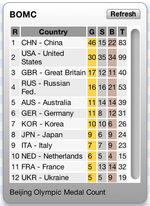Backwardness
“If you don’t move forward, sooner or later you begin to move backward. Unless you have the brakes on.”
Backwardness is a theory developed by Alexander Gerschenkron that states that the more backward something is when it begins then the more likely it is to do better than something that is in front of it. This theory is most commonly explained through the parable of the tortoise and the hare. The hare was winning early on in the race, but because he had expended so much energy establishing the course of the race he became exhausted, meanwhile the tortoise was able to take advantage of all his hard work.
Applications[edit]
Economy[edit]
Gerschenkron postulated that the more backward a country was economically when it started to grow the faster and stronger it would grow...when it eventually did start to grow. There are a couple of African countries that question the validity of this theory as they have slipped further and further into backwardness as the years have gone on. According to the backwardness theory Somalia, a war torn splintered nation suffering from famine, rampant corruption, warlords, piracy, and hot temperatures, is the country that stands to grow the fastest and strongest in the world.
Gerschenkron furthermore failed to mention just exactly how backwardness was to be measured[1] but he left a clue for wily individuals to discover. He took a map of Europe and drew two lines from the United Kingdom, one leading to Russia and one leading to the countries of the Balkans. He then wrote 'developed' above the picture of the UK and 'backward' above Russia and the Balkan countries. Questions were subsequently raised over Gerschekron's racial bias. He also received an unsolicited visit from the KGB a few days later and hasn't been seen since.
There has been some elements of the backwardness theory being displayed in the growth of modern day China. While China had a wealth of history going back over 5000 years and at the time of the Roman Empire had their own empire to rival the Romans, but starting sometime around the 1800's it all went downhill. The european countries tricked most of the chinese into becoming druggos, and then withheld their juice until the Chinese government gave them a significant amount of loot. This plan backfired on the Europeans as the resulting stagnation and subsequent backwardness that lasted for almost 200 years ended up making the Chinese citizens tolerate working for a pittance. They were also able to steal all of the business and management acumen that had been acumulated by the Europeans throughout the years[2]. This then allowed the country to become the premier cheap and poor quality manufacturing capital of the world. As a result of the economic growth that followed the majority of chinese now work for two pittances instead of one.
Social[edit]
Applying the theory to a social setting means that someone with a low friend quotient when they are younger should end up with more friends by the time they have graduated from high school. So far there has been a lack of supporting evidence.
The theory also holds that nations who institute social reforms such as women's suffrage, civil rights, an emphasis upon freedom etc, the later they institute those reforms the more socially progressive they should become in a shorter amount of time han those who instituted those reforms earlier. As many Africaican and middle eastern countries have yet to institute any form of social reform the theory has yet to be tested in this way.
Education[edit]
A lot of experiments have been conducted in which slack jawed yokels have been placed into university and hoped that going to university will cure them of their chronic slackness. This usually doesn't work, although there are a few minor reports of high achievers in high school dropping out of university, much to the smugness of the rest of the gaping slack jawed yokels.
Running[edit]
As in the tale of the tortoise and the hare the backwardness theory applies perfectly to running. This is most obvious in the 400 metre race. In that race people are spaced out several metres behind one another at the start of the race, then once the gun is fired the ones who are farthest at the back close the gap with the person who is closest to the front at a faster rate than those who are closer to the front. This was discovered by the tortoise outrunning the hare.
Comparison[edit]
The backwardness model is often compared with the Rotovian take-off model developed by W.W. Rostow, which presents a much more linear model of growth. It states that a country that starts off more 'forward'[3] will end up more forward in the end than the backward company. He points to countries such as those in western Europe, which despite being less backward than China are economically, socially, and educationally more...forward than China. The theory falls down when it comes to the Olympics, as the Chinese earn significantly more Olympic gold medals than any European country.[4]
See Also[edit]
Footnotes[edit]
- ↑ Which makes the whole theory pointless.
- ↑ Although they decided that bribing someone was a crime only if you weren't in the employ of the Chinese government
- ↑ Rostow also refuses to say how exactly you are meant to measure this concept.
- ↑ It is clearly not based upon population as Australia earns way more medals per capita.


